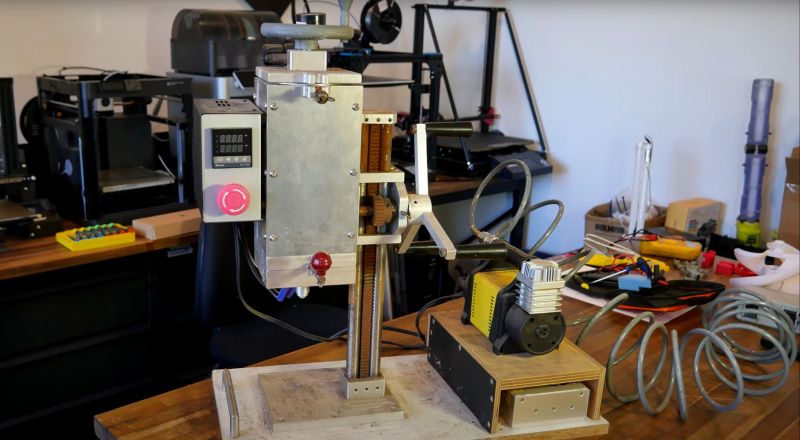When [Michael] over at the Teaching Tech YouTube channel bought a hobby injection molding machine a long time ago, one of the plans he had with it was to use it for grinding up waste bits of PLA filament for injection molding. Since the machine was bought from a US shop and [Michael] is based in Australia it required some modifications to adapt it to the local 220+ VAC mains, followed by adding a PID temperature controller and a small compressor to provide the compressed air rather than from a large shop compressor.
Although [Michael] had discussed using the machine for PLA with the seller to confirm that this would work, a user error meant that the now defective unit had been sitting idly for many years, until recently.
Since the machine had been gathering dust and rust in the garage, fixing the machine up took a complete teardown to remove corrosion and resolve other issues. After this the original fault was identified, which turned out to be a shorted wire near the heater which had been turned up to a too high temperature, leading to the release of magic smoke and banishment of the machine to the Pit of Despair, AKA the shadowy depths of one’s garage.
In this first installment, [Michael] cleaned up the machine and restored it to a working state. In the next part injection molding will be attempted again, which should give some idea of the feasibility of turning scraps of PLA and failed 3D prints into smooth injection molded parts, assuming you have the CNC machine or patience to carve out the requisite molds, of course.

















Aus was always 240V – indeed I often measure my power at 250V or so…. a while ago they theoretically changed it to ” 230 V (+10% to -6%), therefore providing an allowable voltage supply range between 253 V to 216 V” but I’m yet to ever see anything under 240..
Crappy power supplies that were meant for the older 220V in the EU tended to last only a few months..
We all have a hard time understanding why the USA is a low 120V, unless you like having thicker wires..
It probably has to do with arbitrary business decisions when the first grids got established in the US/Europe.
History:
https://en.m.wikipedia.org/wiki/Mains_electricity#History
The first major electrical power plant in the US (and probably the world) was 110VDC. That was partially a limitation of the equipment and partially a safety limit – 110V was considered low enough to not be immediately deadly if you touched it.
That gave the US an installed base of 110V equipment – light bulbs and motors as well as wiring, switches, and outlets.
When AC equipment became available, the US stuck with 110VAC. The 110VDC light bulbs and other appliances could run on 110VAC easily enough.
110V is somewhat safer than 230V. The US had to much invested in 110V by the time 230V was available to make a switch over economical.
As in many things, the US was ahead of the times. The solutions were suboptimal, but were kept because switching to a better system would have cost too much. The rest of the world followed, but learned from the mistakes made in the US.
Unless you live in Brazil, where both 110VAC and 220VAC are available, depending on where you live in the country. 🙃
With the split-phase system, the US has 220 availabe for all major appliances. You can even get 220 outlets installed for larger window AC units.
Plus, as advanced as Japan is, they use 100 volts.
I suspect the cost of not doing the change has been much much higher than the cost of doing it would have been..
The same with metric. I remember when Aus changed, and yes it was a lot of work. But it was done, and after 50 years nobody would think any different – the US should have done it inthe same time frame.. But yes, I agree, voltage is different, but if you look around the world the US is the only major economy with the low voltage..
Japan no longer has a 100 volt standard?
We are still very firmly stuck at the barely useable (for workshop and large appliance use) 100V here in Japan.
You can get 200V split phase if you need more power, but that’s still significantly less than what my toaster ran on back in Australia…
Watching the video, I thought hitting the shaft with a claw hammer will be interesting. And it was! Thank you.
“…used a drill bit to ream the inside…” NOOOOOOOOOOOOOO! STOP!